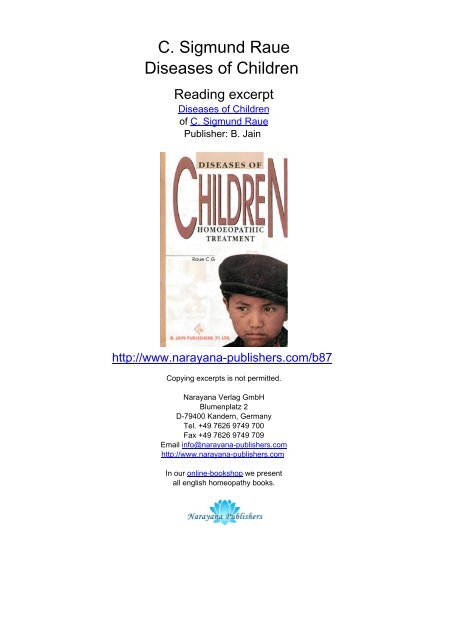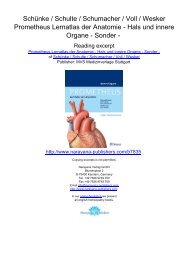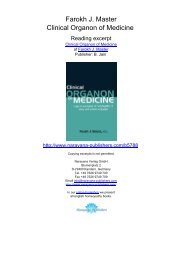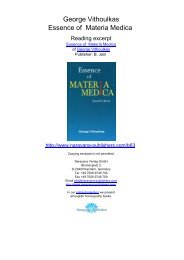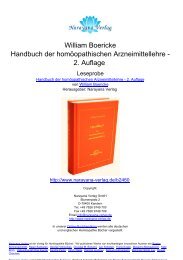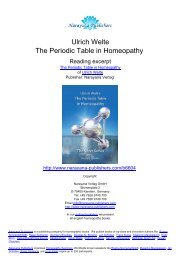C. Sigmund Raue Diseases of Children - Homeopathy books ...
C. Sigmund Raue Diseases of Children - Homeopathy books ...
C. Sigmund Raue Diseases of Children - Homeopathy books ...
Create successful ePaper yourself
Turn your PDF publications into a flip-book with our unique Google optimized e-Paper software.
C. <strong>Sigmund</strong> <strong>Raue</strong><br />
<strong>Diseases</strong> <strong>of</strong> <strong>Children</strong><br />
Reading excerpt<br />
<strong>Diseases</strong> <strong>of</strong> <strong>Children</strong><br />
<strong>of</strong> C. <strong>Sigmund</strong> <strong>Raue</strong><br />
Publisher: B. Jain<br />
http://www.narayana-publishers.com/b87<br />
Copying excerpts is not permitted.<br />
Narayana Verlag GmbH<br />
Blumenplatz 2<br />
D-79400 Kandern, Germany<br />
Tel. +49 7626 9749 700<br />
Fax +49 7626 9749 709<br />
Email info@narayana-publishers.com<br />
http://www.narayana-publishers.com<br />
In our online-<strong>books</strong>hop we present<br />
all english homeopathy <strong>books</strong>.
CHAPTER II.<br />
THE METHODS OF CLINICAL EXAMINATION.<br />
The Periods <strong>of</strong> Infancy and Childhood; Morbidity and<br />
Mortality.—Infancy may be divided into three distinct<br />
periods, namely, the new-born, the period <strong>of</strong> early infancy<br />
and the dentition period. No sharp boundary lines can be<br />
drawn to separate these periods into distinct stages, as this<br />
classification is purely arbitrary and exists only for the sake<br />
<strong>of</strong> conveniently studying and grouping certain physiological<br />
and pathological peculiarities belonging to them.<br />
Infancy may be said to terminate with the completion <strong>of</strong><br />
weaning, and, although the entire teething period (twentyfour<br />
to thirty months) is sometimes spoken <strong>of</strong> as " infancy,"<br />
still the majority <strong>of</strong> pediatrists consider this terminated at the<br />
end <strong>of</strong> a year, when the child should be able to take a certain<br />
amount <strong>of</strong> solid food and plain cow's milk. Childhood begins<br />
from this time on and extends up to the period <strong>of</strong> puberty<br />
(twelfth to fourteenth year in females; fourteenth to sixteenth<br />
year in males). Childhood, again, is divided into early child<br />
hood, or the milk-tooth period, occupying the first to sixt<br />
year and later childhood, the sixth to twelfth year, during<br />
which time most <strong>of</strong> the permanent teeth erupt and physical<br />
and physiological processes more closely attain to the adult<br />
type.<br />
The <strong>Diseases</strong> <strong>of</strong> Infancy and Childhood.—While in many<br />
instances it is correct and permissible to speak <strong>of</strong> diseases <strong>of</strong><br />
children, still a large number <strong>of</strong> diseases encountered in childhood<br />
are but the ordinary ailments that affect all mankind in<br />
general. Their course, however, is so modified by the immature<br />
or exaggerated anatomical structure and physiological<br />
activity <strong>of</strong> the child's economy that they differ in many<br />
respects from the type <strong>of</strong> the disease as seen in adults. Croup-<br />
Excerpt from C. <strong>Sigmund</strong> <strong>Raue</strong><br />
„<strong>Diseases</strong> <strong>of</strong> <strong>Children</strong> Homoeopathic Treatment“<br />
Publisher: B. Jain Publishers Ltd.<br />
Excerpted by Narayana Publishers, 79400 Kandern,<br />
Tel.: +49 (0) 7626 974 970-0
THE METHODS OF CLINICAL EXAMINATION. 31<br />
ous pneumonia, typhoid fever, enteritis, etc., belong to this<br />
group. Capillary bronchitis, spasmodic, croup, the exanthemata<br />
and a number <strong>of</strong> other contagious diseases belong<br />
almost exclusively to the period <strong>of</strong> childhood, while rickets<br />
and hereditary syphilis are distinctly diseases <strong>of</strong> children.<br />
The new-born is particularly susceptible to septic infection<br />
on account <strong>of</strong> the open state <strong>of</strong> the umbilicus and the delicate<br />
nature <strong>of</strong> the epidermis. Besides, there are distinct pathological<br />
conditions belonging to this period. They are spoken<br />
<strong>of</strong> as the diseases and malformations <strong>of</strong> the new-born (Neonatorum).<br />
The young infant is particularly susceptible to mycotic<br />
disease <strong>of</strong> the mouth (thrush) owing to the absence <strong>of</strong> normal<br />
buccal secretion. It may also develop capillary bronchitis<br />
or contract whooping cough or succumb as a result <strong>of</strong> congenital<br />
debility, hereditary syphilis or early tuberculous infection.<br />
The teething period predisposes to gastro-intestinal derangements,<br />
although in this period <strong>of</strong> infancy a large number<br />
<strong>of</strong> infants succumb to broncho-pneumonia. Disturbances<br />
<strong>of</strong> nutrition belong to this period—marasmus, rickets,<br />
scurvy.<br />
Childhood proper gives us the largest number <strong>of</strong> acute infectious<br />
diseases. The intermingling <strong>of</strong> children on the<br />
street and at school explains the prevalence <strong>of</strong> contagious disease<br />
at this period <strong>of</strong> life.<br />
Mortality.—Nearly 10 per cent, <strong>of</strong> all infants die during<br />
the first month <strong>of</strong> life (Eröss). From a study <strong>of</strong> the death<br />
reports <strong>of</strong> New York City, Holt found that about one-fourth<br />
<strong>of</strong> all deaths occur during the first year <strong>of</strong> life and nearly onethird<br />
during the first two years. The causes for this high<br />
mortality are mainly congenital debility, improper feeding<br />
and the infections.<br />
The largest number <strong>of</strong> deaths occurs from gastro-intestinal<br />
diseases, which are most fatal in the hot summer months.<br />
They furnish about 35 per cent, <strong>of</strong> deaths. Next come the<br />
Excerpt from C. <strong>Sigmund</strong> <strong>Raue</strong><br />
„<strong>Diseases</strong> <strong>of</strong> <strong>Children</strong> Homoeopathic Treatment“<br />
Publisher: B. Jain Publishers Ltd.<br />
Excerpted by Narayana Publishers, 79400 Kandern,<br />
Tel.: +49 (0) 7626 974 970-0
32 DISEASES OF CHILDREN.<br />
acute diseases <strong>of</strong> the respiratory tract, 21 per cent. Other<br />
prominent fatal diseases are whooping cough, 12 per cent;<br />
congenital syphilis, 10 per cent.; measles, 9 per cent. (Ash-<br />
BY and WRIGHT.)<br />
Growth and Development.—The rate <strong>of</strong> increase in the infant's<br />
weight is a safe criterion for judging <strong>of</strong> its progress,<br />
while continued loss in weight possesses distinct diagnostic<br />
significance. Absence <strong>of</strong> the regular weekly gain in weight<br />
implies improper feeding providing there are no signs <strong>of</strong><br />
disease present. When not directly traceable to insufficient<br />
nourishment or indigestion we should suspect the advent <strong>of</strong><br />
marasmus, or the beginning <strong>of</strong> a tuberculous meningitis, or<br />
general infantile tuberculosis.<br />
Progressive increase in weight cannot, however, be looked<br />
upon as an invariably favorable sign. It is well known that<br />
syphilitic infants <strong>of</strong>ten look fat and well nourished, but may,<br />
nevertheless, die very unexpectedly. Budin (Annales du Med.<br />
et de Chir., June, 1900) has observed that infants suffering<br />
from various acute disorders may gain in weight suddenly<br />
and then die in the course <strong>of</strong> a few days. In some <strong>of</strong> these<br />
cases there is localized oedema and deficient urinary excretion.<br />
In febrile disturbances he has also noted increase in<br />
weight at times.<br />
Hand in hand with increase in weight there should also be<br />
a regular increase in length in the normally developing infant.<br />
According to Schmid-Monnard there is an increase in<br />
length <strong>of</strong> three-quarters <strong>of</strong> an inch per month during the first<br />
year. The male new-born measures 50 c.m. in length; the<br />
female, 49 c.m.<br />
During the first two months <strong>of</strong> life there is a gain <strong>of</strong> from<br />
3 to 4 c.m. ; in the following three months, 2 c.m.; and in<br />
the last months <strong>of</strong> the first year, 1.5 c.m. At the end <strong>of</strong> the<br />
first year the total gain is 19 to 23 c.m. ; at the end <strong>of</strong> the<br />
second, 10 c.m., and during the third year, 7 to 8 c.m. The<br />
male slightly exceeds the female in length (MONTI).<br />
The head has a greater circumference than the chest at<br />
Excerpt from C. <strong>Sigmund</strong> <strong>Raue</strong><br />
„<strong>Diseases</strong> <strong>of</strong> <strong>Children</strong> Homoeopathic Treatment“<br />
Publisher: B. Jain Publishers Ltd.<br />
Excerpted by Narayana Publishers, 79400 Kandern,<br />
Tel.: +49 (0) 7626 974 970-0
THE METHODS OF CLINICAL EXAMINATION. 3 3<br />
birth; at the middle <strong>of</strong> the first year the measurements begin<br />
to approximate each other and at the end <strong>of</strong> the year the<br />
chest grows larger than the head. A comparison <strong>of</strong> the circumference<br />
<strong>of</strong> the head with that <strong>of</strong> the chest, therefore,<br />
<strong>of</strong>fers important clinical data. In rickets the head is some-<br />
what larger than normal while the chest is abnormally small.<br />
In hydrocephalus the head is unusually large and the chest<br />
normal, while in microcephalus the head is proportionately<br />
much smaller than normal.<br />
The diagrams shown in the illustrations (Figs. 7 and 8) have<br />
been constructed from the results <strong>of</strong> measurements <strong>of</strong> 200<br />
Excerpt from C. <strong>Sigmund</strong> <strong>Raue</strong><br />
„<strong>Diseases</strong> <strong>of</strong> <strong>Children</strong> Homoeopathic Treatment“<br />
Publisher: B. Jain Publishers Ltd.<br />
Excerpted by Narayana Publishers, 79400 Kandern,<br />
Tel.: +49 (0) 7626 974 970-0
34 DISEASES OF CHILDREN.<br />
healthy infants by Hedlicka and Pisek (Chapin's Theory and<br />
Practice <strong>of</strong> Infant Feeding, pp. 306 and 307).<br />
The initial weight, roughly stated, may be said to double<br />
itself in five months and treble itself at the end <strong>of</strong> the first<br />
year.<br />
Excerpt from C. <strong>Sigmund</strong> <strong>Raue</strong><br />
„<strong>Diseases</strong> <strong>of</strong> <strong>Children</strong> Homoeopathic Treatment“<br />
Publisher: B. Jain Publishers Ltd.<br />
Excerpted by Narayana Publishers, 79400 Kandern,<br />
Tel.: +49 (0) 7626 974 970-0
C. <strong>Sigmund</strong> <strong>Raue</strong><br />
<strong>Diseases</strong> <strong>of</strong> <strong>Children</strong><br />
Homoeopathic treatment<br />
776 pages,<br />
publication 2000<br />
More homeopathy <strong>books</strong> on www.narayana-publishers.com


